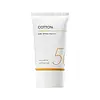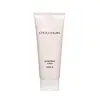What's inside
What's inside
 Key Ingredients
Key Ingredients

 Benefits
Benefits

 Concerns
Concerns

 Ingredients Side-by-side
Ingredients Side-by-side

Water
Skin ConditioningZinc Oxide
Cosmetic ColorantCyclohexasiloxane
EmollientButyloctyl Salicylate
Skin ConditioningPropanediol
SolventPropylheptyl Caprylate
EmollientPolyglyceryl-3 Polydimethylsiloxyethyl Dimethicone
Skin ConditioningDicaprylyl Carbonate
EmollientIsododecane
EmollientCaprylyl Methicone
Skin ConditioningDioctyl Adipate
Polyethylene Naphthalate
Methyl Methacrylate Crosspolymer
Melaleuca Alternifolia Leaf Extract
PerfumingHydrogenated Lecithin
EmulsifyingDisteardimonium Hectorite
StabilisingMagnesium Sulfate
Titanium Dioxide
Cosmetic ColorantTriethoxycaprylylsilane
1,2-Hexanediol
Skin ConditioningPolyglyceryl-2 Dipolyhydroxystearate
Skin ConditioningPolymethylsilsesquioxane
Lauryl Polyglyceryl-3 Polydimethylsiloxyethyl Dimethicone
Skin ConditioningGlyceryl Caprylate
EmollientCaprylyl Glycol
EmollientGlycerin
HumectantEthylhexylglycerin
Skin ConditioningDipropylene Glycol
HumectantPanthenol
Skin ConditioningCetearyl Olivate
Sorbitan Olivate
EmulsifyingTocopherol
AntioxidantButylene Glycol
HumectantCeramide NP
Skin ConditioningAllantoin
Skin ConditioningParfum
MaskingWater, Zinc Oxide, Cyclohexasiloxane, Butyloctyl Salicylate, Propanediol, Propylheptyl Caprylate, Polyglyceryl-3 Polydimethylsiloxyethyl Dimethicone, Dicaprylyl Carbonate, Isododecane, Caprylyl Methicone, Dioctyl Adipate, Polyethylene Naphthalate, Methyl Methacrylate Crosspolymer, Melaleuca Alternifolia Leaf Extract, Hydrogenated Lecithin, Disteardimonium Hectorite, Magnesium Sulfate, Titanium Dioxide, Triethoxycaprylylsilane, 1,2-Hexanediol, Polyglyceryl-2 Dipolyhydroxystearate, Polymethylsilsesquioxane, Lauryl Polyglyceryl-3 Polydimethylsiloxyethyl Dimethicone, Glyceryl Caprylate, Caprylyl Glycol, Glycerin, Ethylhexylglycerin, Dipropylene Glycol, Panthenol, Cetearyl Olivate, Sorbitan Olivate, Tocopherol, Butylene Glycol, Ceramide NP, Allantoin, Parfum
Water
Skin ConditioningHydrogenated Polydecene
EmollientMyristic Acid
CleansingGlycerin
HumectantPotassium Hydroxide
BufferingLauric Acid
CleansingPotassium Cocoyl Glycinate
Lauryl Hydroxysultaine
CleansingLauryl Betaine
CleansingPalmitic Acid
EmollientAcrylates/C10-30 Alkyl Acrylate Crosspolymer
Emulsion StabilisingLaminaria Japonica Extract
Skin ProtectingEclipta Prostrata Leaf Extract
Skin ConditioningVelvet Extract
HumectantThymus Vulgaris Extract
PerfumingCornus Officinalis Fruit Extract
Skin ConditioningAngelica Gigas Root Extract
Skin ConditioningMalt Extract
Skin ProtectingSaponaria Officinalis Leaf/Root Extract
Skin ConditioningEucalyptus Globulus Leaf Extract
PerfumingPanax Ginseng Root Extract
EmollientHydrogenated Lecithin
EmulsifyingOryza Sativa Bran Water
MaskingStearic Acid
CleansingHydrated Silica
AbrasivePolyquaternium-22
Sodium Chloride
MaskingBeta-Glucan
Skin ConditioningButylene Glycol
HumectantFructooligosaccharides
HumectantHydrolyzed Hyaluronic Acid
HumectantEthyl Hexanediol
Solvent1,2-Hexanediol
Skin ConditioningEthylhexylglycerin
Skin ConditioningParfum
MaskingWater, Hydrogenated Polydecene, Myristic Acid, Glycerin, Potassium Hydroxide, Lauric Acid, Potassium Cocoyl Glycinate, Lauryl Hydroxysultaine, Lauryl Betaine, Palmitic Acid, Acrylates/C10-30 Alkyl Acrylate Crosspolymer, Laminaria Japonica Extract, Eclipta Prostrata Leaf Extract, Velvet Extract, Thymus Vulgaris Extract, Cornus Officinalis Fruit Extract, Angelica Gigas Root Extract, Malt Extract, Saponaria Officinalis Leaf/Root Extract, Eucalyptus Globulus Leaf Extract, Panax Ginseng Root Extract, Hydrogenated Lecithin, Oryza Sativa Bran Water, Stearic Acid, Hydrated Silica, Polyquaternium-22, Sodium Chloride, Beta-Glucan, Butylene Glycol, Fructooligosaccharides, Hydrolyzed Hyaluronic Acid, Ethyl Hexanediol, 1,2-Hexanediol, Ethylhexylglycerin, Parfum
 Reviews
Reviews

Ingredients Explained
These ingredients are found in both products.
Ingredients higher up in an ingredient list are typically present in a larger amount.
1,2-Hexanediol is a synthetic liquid and another multi-functional powerhouse.
It is a:
- Humectant, drawing moisture into the skin
- Emollient, helping to soften skin
- Solvent, dispersing and stabilizing formulas
- Preservative booster, enhancing the antimicrobial activity of other preservatives
Butylene Glycol (or BG) is used within cosmetic products for a few different reasons:
Overall, Butylene Glycol is a safe and well-rounded ingredient that works well with other ingredients.
Though this ingredient works well with most skin types, some people with sensitive skin may experience a reaction such as allergic rashes, closed comedones, or itchiness.
Learn more about Butylene GlycolEthylhexylglycerin (we can't pronounce this either) is commonly used as a preservative and skin softener. It is derived from glyceryl.
You might see Ethylhexylglycerin often paired with other preservatives such as phenoxyethanol. Ethylhexylglycerin has been found to increase the effectiveness of these other preservatives.
Glycerin is already naturally found in your skin. It helps moisturize and protect your skin.
A study from 2016 found glycerin to be more effective as a humectant than AHAs and hyaluronic acid.
As a humectant, it helps the skin stay hydrated by pulling moisture to your skin. The low molecular weight of glycerin allows it to pull moisture into the deeper layers of your skin.
Hydrated skin improves your skin barrier; Your skin barrier helps protect against irritants and bacteria.
Glycerin has also been found to have antimicrobial and antiviral properties. Due to these properties, glycerin is often used in wound and burn treatments.
In cosmetics, glycerin is usually derived from plants such as soybean or palm. However, it can also be sourced from animals, such as tallow or animal fat.
This ingredient is organic, colorless, odorless, and non-toxic.
Glycerin is the name for this ingredient in American English. British English uses Glycerol/Glycerine.
Learn more about GlycerinHydrogenated Lecithin is created from the hydrogenation of lecithin (a group of phospholipids). Hydrogenation is a chemical reaction between hydrogen and another element.
This ingredient is an emollient and emulsifier. As an emollient, it helps soften skin by trapping moisture within. As an emulsifier, it prevents oil and water ingredients from separating.
Parfum is a catch-all term for an ingredient or more that is used to give a scent to products.
Also called "fragrance", this ingredient can be a blend of hundreds of chemicals or plant oils. This means every product with "fragrance" or "parfum" in the ingredients list is a different mixture.
For instance, Habanolide is a proprietary trade name for a specific aroma chemical. When used as a fragrance ingredient in cosmetics, most aroma chemicals fall under the broad labeling category of “FRAGRANCE” or “PARFUM” according to EU and US regulations.
The term 'parfum' or 'fragrance' is not regulated in many countries. In many cases, it is up to the brand to define this term.
For instance, many brands choose to label themselves as "fragrance-free" because they are not using synthetic fragrances. However, their products may still contain ingredients such as essential oils that are considered a fragrance by INCI standards.
One example is Calendula flower extract. Calendula is an essential oil that still imparts a scent or 'fragrance'.
Depending on the blend, the ingredients in the mixture can cause allergies and sensitivities on the skin. Some ingredients that are known EU allergens include linalool and citronellol.
Parfum can also be used to mask or cover an unpleasant scent.
The bottom line is: not all fragrances/parfum/ingredients are created equally. If you are worried about fragrances, we recommend taking a closer look at an ingredient. And of course, we always recommend speaking with a professional.
Learn more about ParfumWater. It's the most common cosmetic ingredient of all. You'll usually see it at the top of ingredient lists, meaning that it makes up the largest part of the product.
So why is it so popular? Water most often acts as a solvent - this means that it helps dissolve other ingredients into the formulation.
You'll also recognize water as that liquid we all need to stay alive. If you see this, drink a glass of water. Stay hydrated!
Learn more about Water